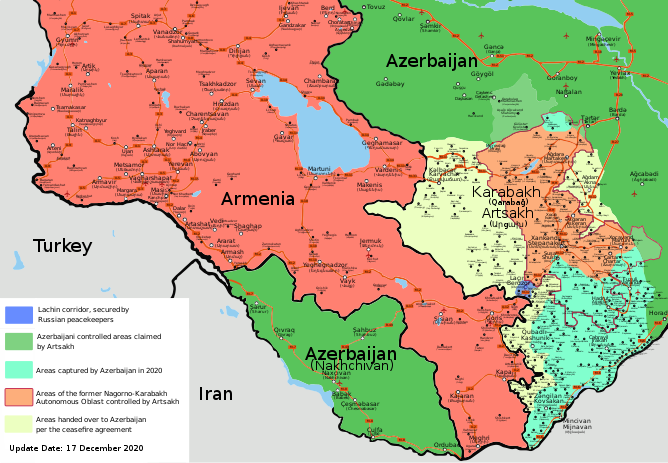Nagorno-Karabakh, balanç de la (guerra) del 2020
Los 44 días de guerra por el enclave de Nagorno Karabaj –entre el 27 de septiembre y el 10 de noviembre– costaron la vida al menos a 5.649 personas, la gran mayoría soldados, con la particularidad de que el número de bajas fue casi igual en los dos bandos. Durante la guerra, el Gobierno de Azerbaiyán solo informó de las víctimas civiles –94 muertos y más de 400 heridos– de los bombardeos armenios pero no comunicó las muertes de soldados hasta el pasado jueves: fueron 2.783 muertos, 1.245 heridos y un centenar de desaparecidos. Armenia y la llamada República de Artsaj perdieron 2.718 soldados, y varios cientos se dan por desaparecidos. Los civiles muertos fueron 54.
El número total de víctimas coincide con el que adelantó Rusia poco antes del fin de la guerra y da idea de lo cruenta que fue. Azerbaiyán utilizó drones con profusión y la resistencia armenio-karabají fue férrea ante un ejército muy superior. La victoria de Azerbaiyán tuvo un alto coste. El fin de las hostilidades mediado por el presidente Vladímir Putin firmado el 10 de noviembre implicaba un canje de prisioneros que aún no se ha producido. Human Rights Watch ha denunciado malos tratos a prisioneros armenios.
Mientras, el pasado martes Azerbaiyán tomó bajo su control el distrito de Lachin, el tercero y último de los que rodean el territorio original de Nagorno-Karabaj y que con arreglo al acuerdo de paz debían ser retornados. Los otros cuatro, de los siete ocupados por Armenia en 1994, fueron recuperados por las armas. Casi 2.000 soldados rusos actúan como fuerzas de paz en lo que queda de la República de Artsaj y deben garantizar la conexión entre esta y Armenia por el llamado corredor de Lachin. También esta semana se confirmó que Rusia y Turquía –la gran aliada de Azerbaiyán– tendrán un centro de observación conjunto en el territorio.
---------------------------------------------------------------------
 https://en.wikipedia.org/wiki/2020_Nagorno-Karabakh_war
https://en.wikipedia.org/wiki/2020_Nagorno-Karabakh_war
The 2020 Nagorno-Karabakh war[e] was an armed conflict between Azerbaijan, supported by Turkey, and the self-proclaimed Republic of Artsakh together with Armenia, in the disputed region of Nagorno-Karabakh and surrounding territories. It was the latest escalation of an unresolved conflict over the region, which is internationally recognized as part of Azerbaijan, but partially governed by Artsakh, a breakaway state with an Armenian ethnic majority.[f]
Clashes began on the morning of 27 September 2020 along the Nagorno-Karabakh Line of Contact, which had been established in the aftermath of the First Nagorno-Karabakh War (1988–1994). In response, Armenia and Artsakh introduced martial law and total mobilization,[78][79] while Azerbaijan introduced martial law,[80] a curfew and partial mobilization.[81] Turkey provided military support to Azerbaijan, although the extent of this support has been disputed.[82][83] Turkey's involvement is thought to have been an attempt to extend its sphere of influence, both by increasing the standing of Azerbaijan in the conflict and by marginalizing Russia's influence over the region.[82][84]
International analysts believe that fighting likely began with an Azerbaijani offensive,[82][85] with the primary goal of reclaiming the less mountainous districts of southern Nagorno-Karabakh, which were easier to take than the region's well-fortified interior.[86][87] The war was marked by the deployment of drones, sensors, long-range heavy artillery[88] and missile strikes, as well as by state propaganda and the use of official social media accounts in online information warfare.[89] Total casualties on both sides may be in the low thousands.[90] Numerous countries and the United Nations strongly condemned the fighting and called on both sides to de-escalate tensions and resume meaningful negotiations without delay.[91] Three ceasefires brokered by Russia, France, and the United States failed to stop the fighting.[92]
Following the capture of Shusha, the second-largest settlement in Nagorno-Karabakh, a ceasefire agreement was signed between the President of Azerbaijan, Ilham Aliyev, the Prime Minister of Armenia, Nikol Pashinyan, and the President of Russia, Vladimir Putin, ending all hostilities in the area from 00:00, 10 November 2020 Moscow Time.[93][94][95] The President of Artsakh, Arayik Harutyunyan, also agreed to end the hostilities.[96] Under the agreement, the warring sides will keep control of their currently held areas within Nagorno-Karabakh, while Armenia will return the surrounding territories it occupied in 1994 to Azerbaijan. Azerbaijan will also gain land access to its Nakhchivan exclave bordering Turkey and Iran.[97] Approximately 2,000 Russian soldiers will be deployed as peacekeeping forces along the Lachin corridor between Armenia and Nagorno-Karabakh for a mandate of at least five years.[24]





